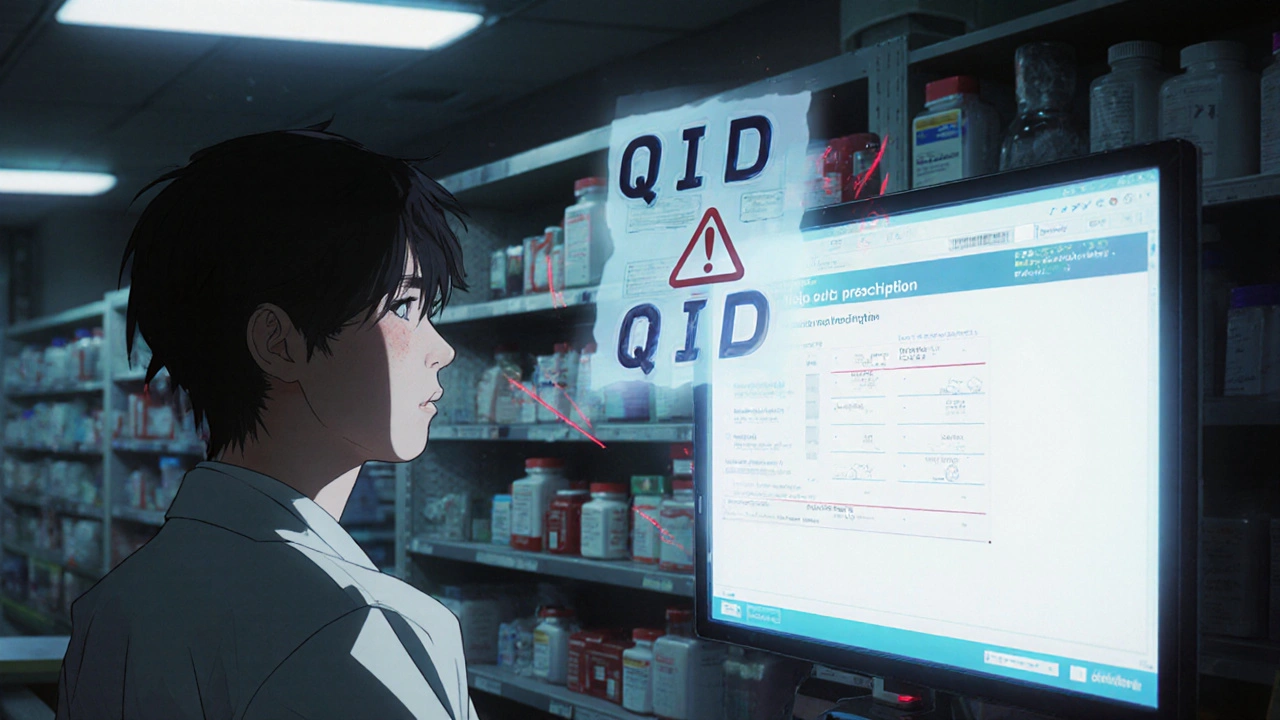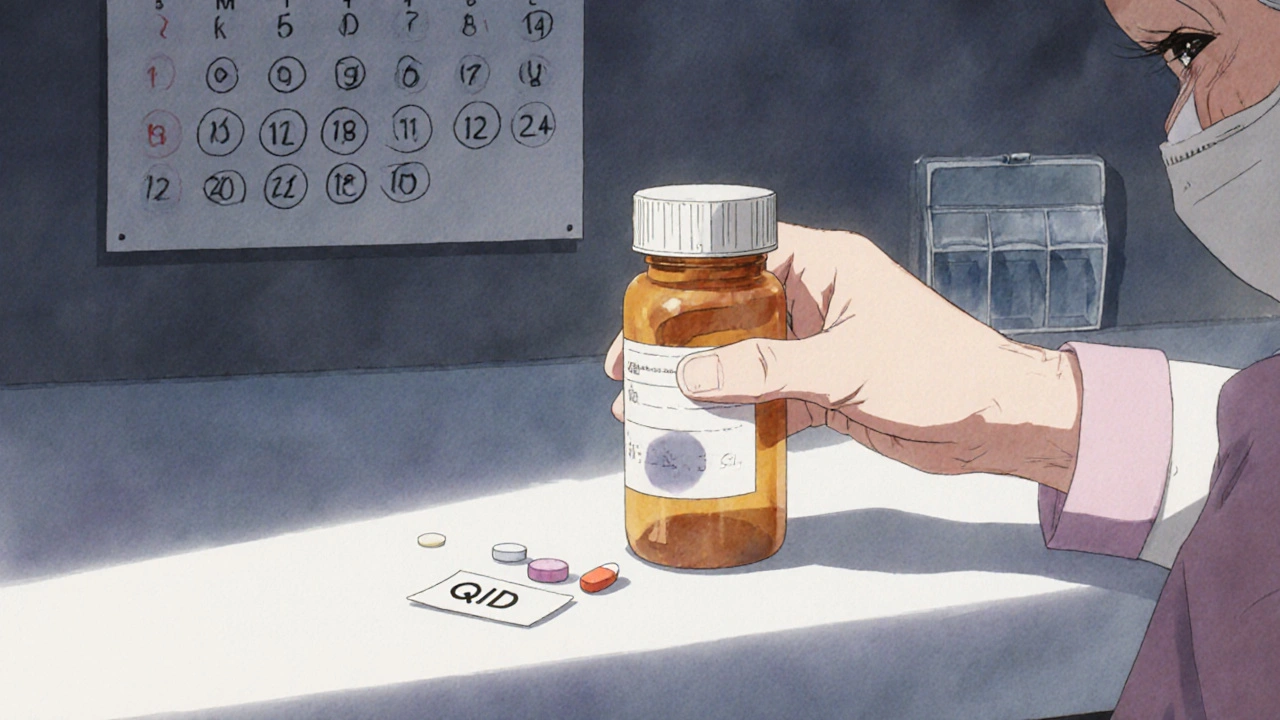QD vs. QID isn’t just a tiny typo on a prescription slip-it’s a silent killer in hospitals, pharmacies, and homes across the country. One letter changes everything: QD means once daily. QID means four times daily. Mix them up, and a patient could be taking four times the dose they were supposed to. That’s not a hypothetical risk. It’s happened. And it keeps happening-even in 2025.
Why QD and QID Are Still a Problem
You’d think by now, after more than 20 years of warnings, doctors and pharmacists would have stopped using QD and QID. But they haven’t. These abbreviations come from Latin-quaque die for once daily, quater in die for four times daily. They’ve been around since the 1800s. And while they seem harmless at a glance, they’re dangerously easy to misread. A handwritten "QD" can look like "QID" if the pen slips, the ink smudges, or the handwriting is rushed. A tired nurse scanning a chart might miss the dot under the "D." An automated system might misinterpret the scan. Even in electronic health records, some providers still type "QD" because it’s faster. And patients? They don’t know the difference. Most have never heard of Latin medical abbreviations. The numbers don’t lie. A 2018 study in the Journal of Patient Safety found that QD was misread as QID in 12.7% of cases. That’s more than one in eight prescriptions. For new healthcare workers with under five years of experience, the error rate jumps to 18.2%. And it’s not just about mistakes. These errors lead to real harm. The National Coordinating Council for Medication Error Reporting and Prevention classifies QD/QID confusion as a Category E error-meaning it caused patient harm that required intervention-in 78% of documented cases.What Happens When Someone Takes Four Times the Dose
Imagine you’re prescribed a medication for high blood pressure. Your doctor writes "1 tablet QD." You take it once a day, as instructed. But the pharmacist misreads it as QID. You’re now taking four tablets a day. Within days, your blood pressure plummets. You feel dizzy. You almost faint walking to the bathroom. You don’t tell anyone because you think it’s just fatigue. That’s exactly what happened to a patient in California in 2022. The pharmacist dispensed the medication with "take four times daily" instructions. The patient, a 71-year-old retired teacher, took the pills as told. Within a week, her systolic blood pressure dropped to 80. She was hospitalized. Her kidney function dropped. She needed IV fluids and days of monitoring. Or consider the case of a construction inspector who was prescribed a sedative for anxiety. He was told to take one pill QD. He took four. He drove his 7-year-old daughter to school every morning while barely able to keep his eyes open. He didn’t realize anything was wrong until he went for a refill and the pharmacist asked, "Why are you taking this so often?" These aren’t rare stories. A 2021 survey by the National Patient Safety Foundation found that 63% of patients admitted they’d been confused about dosing instructions at least once. QD vs. QID ranked third on their list of most confusing directions-right after "take with food" and "take on empty stomach."Who’s Most at Risk
Elderly patients are the most vulnerable. According to the American Geriatrics Society, 68% of all documented QD/QID errors involve people over 65. Why? They’re often managing five, six, or even ten different medications. Their vision may be fading. Their memory isn’t what it used to be. They rely on labels they don’t fully understand. And they’re less likely to question a pharmacist’s instructions. Patients with chronic conditions-diabetes, heart failure, kidney disease-are also at higher risk. Many of their medications have narrow therapeutic windows. A small overdose can cause serious harm. Warfarin, for example, is a blood thinner. Take it once daily? Fine. Take it four times daily? Your INR can spike to 12.3 (normal is 2-3). That’s a bleeding risk so high it requires emergency hospitalization. And it’s not just the patient. Nurses, pharmacists, and doctors all get caught in the trap. A nurse on Reddit shared a case where a patient’s warfarin dose was misread. The patient’s INR hit 12.3. She was rushed to the ER. The nurse said, "I’ve seen this three times in two years. And every time, it’s because someone saw QD and thought QID."
Why EHR Systems Haven’t Fixed It
You’d think electronic health records would have solved this by now. After all, most systems have built-in alerts. But they don’t always work. A 2021 analysis by the Agency for Healthcare Research and Quality found that even in EHR systems with safety checks, 3.8% of prescriptions still contained QD or QID. Why? Because providers override them. Some doctors still type "QD" out of habit. Others don’t know the system flags it. Some think, "It’s fine-I’ve used this for 20 years." And when they override the warning, the system lets them. No one checks. No one follows up. Even worse, independent practitioners who don’t use EHRs still write prescriptions by hand. A 2023 survey by the American Society of Health-System Pharmacists found that 31% of community pharmacies still receive handwritten prescriptions with QD or QID. That’s nearly one in three. And those are the ones that slip through the digital cracks.What Should Be Written Instead
The fix is simple: write it out. Instead of QD, write "once daily." Instead of QID, write "four times daily." It’s three to five extra characters. That’s it. And the safety payoff is massive. Dr. Jerry Phillips of ISMP said it best: "With only three more letters than the abbreviation it replaces, [writing 'daily'] offers a much safer alternative." And it’s not just about safety. Clear language helps patients understand. A 2023 Johns Hopkins study tested this with 1,500 participants. Half got prescriptions with "QD" and "QID." The other half got "once daily" and "four times daily." The group with plain language had 82% fewer errors in understanding their dosing schedule. Even better? Add a visual. A simple icon-a clock with one dot for once daily, four dots for four times daily-can reinforce the message. Hospitals in Michigan and Minnesota have started including these on labels. Patients remember them better than text.
How Healthcare Systems Are Fighting Back
Change is happening-but slowly. In 2023, the American Medical Association updated its prescribing guidelines to require full words, not abbreviations. The FDA’s 2023 draft guidance says the same. Epic and Cerner, the two biggest EHR vendors, now have "hard stops" in their systems. If you type QD or QID, the system won’t let you save the prescription until you change it. The National Action Alliance for Patient Safety launched the "Clear Communication Campaign" in April 2023 with $45 million in funding from CMS. Their goal? Reduce abbreviation-related errors by 90% by 2026. Hospitals that have fully adopted plain language policies have seen a 42% drop in dosing errors within a year. One hospital in Ohio cut its medication error rate in half after requiring pharmacists to verbally confirm dosing with every patient. That single step reduced QD/QID errors by 67%.What You Can Do-As a Patient or Caregiver
You don’t have to wait for the system to fix itself. Here’s what you can do right now:- Always ask: "Is this once a day or four times a day?" Don’t assume.
- Read the label. If it says "QD" or "QID," ask the pharmacist to explain it in plain English.
- Use a pill organizer with clear labels. Write "1x/day" or "4x/day" on each compartment.
- Take a photo of your prescription label when you pick it up. Compare it to what the doctor told you.
- If you feel dizzy, unusually sleepy, or your blood pressure drops-stop the medication and call your doctor immediately.
The Bigger Picture: Why This Matters
Medication errors cost the U.S. healthcare system $2.1 billion a year. Of that, $780 million comes from dosing frequency mistakes-like QD vs. QID. That’s not just money. It’s hospital beds, emergency visits, lost workdays, and lives. But here’s the good news: this is one of the easiest problems to fix. No new drug. No expensive tech. Just better communication. And the return on investment? $8.70 saved for every $1 spent on training and system updates. We know how to prevent these errors. We’ve known for over two decades. The question isn’t whether we can stop them. It’s whether we’re willing to.What does QD mean on a prescription?
QD stands for "quaque die," which is Latin for "once daily." It means take the medication one time every 24 hours. However, because QD looks similar to QID, it’s often misread as "four times daily," leading to dangerous overdoses. Always ask for the instruction to be written out as "once daily" to avoid confusion.
What does QID mean on a prescription?
QID stands for "quater in die," Latin for "four times daily." It means take the medication four times during your waking hours-not every 6 hours around the clock. For example, doses might be spaced at 7 AM, 1 PM, 7 PM, and 11 PM. Never assume QID means every 6 hours unless your doctor specifically says so.
Why are QD and QID still used if they’re dangerous?
They’re used because they’re old habits. Many doctors learned them in medical school decades ago and haven’t changed. Some still write prescriptions by hand, especially outside large hospital systems. Even in electronic systems, providers sometimes override safety alerts because they think it’s faster or they don’t realize the risk. But major health organizations have banned them since 2004, and new guidelines now require plain language.
Can electronic prescriptions prevent QD/QID errors?
Yes, but not always. Most modern EHR systems now block QD and QID and require you to write "once daily" or "four times daily." However, some providers still bypass these warnings. And handwritten prescriptions from independent doctors still slip through. So while technology helps, it’s not a complete solution without human verification.
What should I do if I think I’ve taken too much medication because of a QD/QID mix-up?
Stop taking the medication immediately. Call your pharmacist or doctor. If you feel dizzy, confused, extremely tired, or your heart is racing or beating too slowly, go to the emergency room. Bring your medication bottle and the original prescription. Many life-threatening overdoses from QD/QID confusion can be reversed if caught early.
Is it safe to rely on the pharmacy’s instructions if they say "take four times daily"?
No-not unless you confirm it with your doctor. Pharmacists are trained to catch errors, but they can’t always know what the doctor intended. If the prescription says "QD" but the label says "four times daily," ask the pharmacist to check with the prescribing doctor. Never assume the label is correct. Always verify with your prescriber if something seems off.

